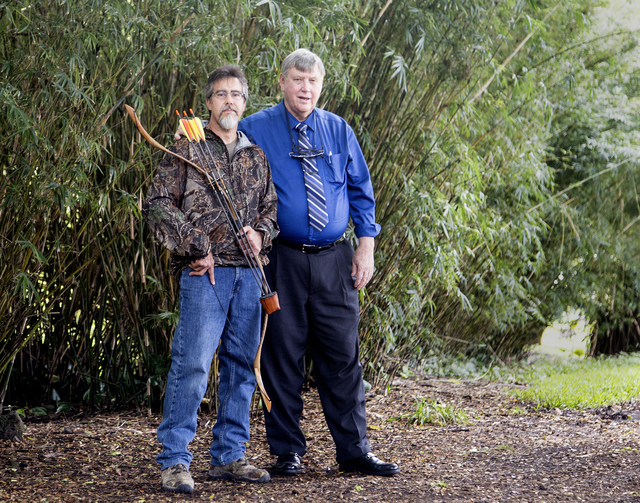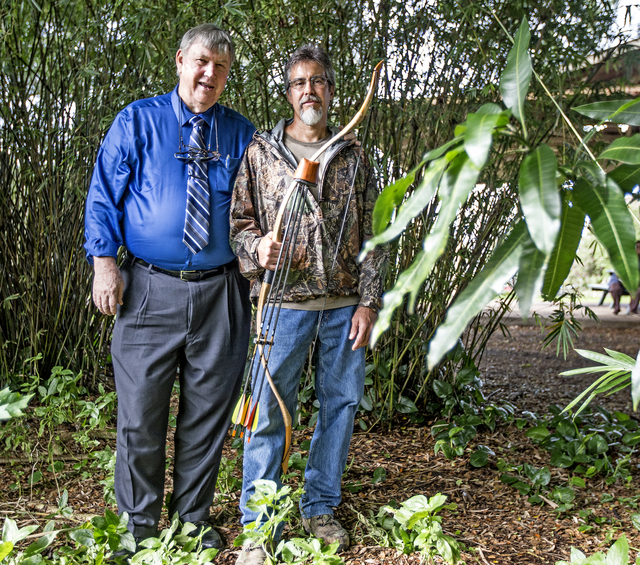The Department of Land and Natural Resources is conducting aerial eradication of feral ungulates in four Maui state forest reserves — and that’s making some hunters on the Big Island and Maui uneasy.
The Maui News reported Nov. 5 the DLNR plans to close areas within the Koolau, Hana, West Maui and Kahikinui state forest reserves for control of feral cattle, pigs, deer and goats. Aerial shooting operations took place Nov. 6 and 12, and are scheduled for Nov. 25 and Dec. 4, 11 and 18.
“They shouldn’t be shooting,” said Jeff DeRego, president of Maui Hunters and Sportsman Club. “They’re shooting, and they’re doing it in places that are actually hunting areas.”
At issue is whether or not Hilo Circuit Judge Glenn Hara barred the state and its contractors from shooting at animals from aircraft on Dec. 17, 2014, when he dismissed a civil suit against Hawaii County by the state, which sought to exempt its employees and contractors from enforcement of county and state laws banning aerial hunting.
The hunters maintain the judge ruled state employees and contractors aren’t exempt from Hawaii Revised Statutes 263-10, which makes shooting at animals from aircraft a misdemeanor punishable by up to a year in jail and a $1,000 fine.
The DLNR takes the view Hara didn’t rule whether state employees or contractors are exempt from the law.
“What they’re essentially saying is that the state doesn’t have to comply with state law,” said Tom Lodge, chairman of Hawaii County Game Management Advisory Commission.
“That is essentially the attitude of DLNR, and to me, that’s how it’s always been. But we disagree (and) the judge disagreed.”
DLNR spokeswoman Deborah Ward said in an email last week the judge “did not rule — one way or the other — whether state employees and contractors are exempt from HRS 263-10. Rather, he dismissed the state’s case and said that the issue should be determined through other legal means.”
Deputy Attorney General Michael Lau argued during the Dec. 17 hearing on the lawsuit that state employees and contractors engaged in animal control are exempted from both county and state aerial eradication bans by “general application law,” and noted police officers and firefighters aren’t ticketed for speeding while responding to a fire.
Hara told Lau the state law as written doesn’t make exceptions for state workers and contractors to its aerial hunting ban, but added the attorney general could “go to the Legislature and create an exemption.”
The judge was on vacation last week and unavailable to comment, according to a clerk.
House Bill 799 was introduced in the 2014 legislative session seeking to exempt state employees and contractors from HRS 263-10, but the measure died in the House Judiciary Committee.
Supporters included DLNR, The Nature Conservancy, the Maui Invasive Species Committee, Oahu Native Species Committee and The Friends of Hakalau Forest National Wildlife Refuge, among others. Those opposed included Hawaii County Game Management Commission, Keaukaha Community Association, Hawaii Hunting Association, Hawaii Sportsmen’s Alliance, Pig Hunters Association of Oahu, the Society for Hawaii Heritage Animals, Big Island Fisheries Alliance and Hawaii Near Shore Fishermen.
The dismissed suit alleged that on Dec. 23, 2013, the state asked county Prosecutor Mitch Roth for an agreement to not prosecute state employees and private contractors who engage in state-sanctioned aerial shooting of animals, but the prosecutor “was not willing to enter into such a stipulation.”
Tony Sylvester, a hunter and former member of the game commission, said last week he’s “kind of flabbergasted.” He called the aerial operations, news of which came from a legal notice and was not disseminated as a press release, “a sleight-of-hand that’s not needed right now.”
Sylvester opined the DLNR would try aerial eradication of ungulates again on the Big Island outside the critical habitat of the native palila bird on Mauna Kea. U.S. District Judge J. Michael Seabright ruled on April 8, 2013, DLNR could continue the shooting of grazing animals from the air within the palila habitat, citing a 1998 court order.
“It’s just a back door to try to set a precedent. They can say, ‘We’re doing this already on Maui,’” Sylvester said.
On Nov. 10, DLNR issued a press release saying it will conduct animal control activities on Mauna Kea that may include aerial shooting in the palila habitat on Monday and Tuesday, and again on Dec. 14 and 15.
Sylvester also objected to DLNR not allowing hunters to cull the feral herds from the ground prior to aerial eradication missions and harvest the meat afterward.
“They’re not allowing hunters to go up into those areas, for whatever reason, if it’s landlocked (by private lands), or they don’t want to open the gate, or whatever,” he said. “They haven’t tried to address any of those other issues, and they have always said they’d address those other areas before they resort to aerial eradication. They’re just jumping straight in to go up there and shoot these animals in a helicopter.”
Ward countered the areas “targeted for control are remote, landlocked by private parcels, and inaccessible to the public.”
“The department seeks to use public hunting for control of feral ungulates where it is safe, feasible and effective. However, methods such as public hunting do not provide an effective means of control of feral ungulates that negatively impact the watersheds in the subject areas,” she said.
“The subject missions for control of feral ungulates are being conducted in the fenced portions of the highest reaches of the Koolau FR, Hana FR and Hanawi NAR. Numbers of animals dispatched is expected to be low. The areas are not accessible to the public and analysis of control alternatives concluded that salvage of animals by any means is not practical or safe due to the inaccessible, multilevel canopy structure, high elevation, steep terrain and unpredictable weather conditions.”
DeRego said some, but not all of the areas targeted for aerial eradication, are inaccessible to hunters.
“One of the sweeps they want to do is in areas that are not fenced, and hunters can reach the area,” he said. “It’s not like the hunters can’t go there.”
DeRego thinks the eradication is not needed at this point, and said DLNR used to call hunters before resorting to shooting from helicopters, but stopped that practice “about two years ago.”
“They used to fly us” to the more inaccessible areas, DeRego said, and added, “I was one of their main sources for gathering up the hunters. They did this special fencing of one area, and they flew us in before anything else happened. Then they said they were not going to fly anybody else in, and they started snaring (animals). Now, that’s one of the areas they’re going in to shoot.” DeRego said he was referring to a valley in the Koolau Forest Reserve near Hana.
“Why would they stop flying us in?” he said. “There’s so many things that could be done without shooting from the air.”
Lodge, who’s a pilot, said he doesn’t object to aerial eradication if it’s needed, but doesn’t think DLNR has demonstrated the need.
“Do whatever you have to to reduce those animals to a manageable number. But what are those numbers? They don’t even know what those numbers are. They’re just shooting to shoot,” he said.
“They need to collect data, input data and catalog data. Our game needs to be considered a natural resource. Everything that was brought to Hawaii was introduced for a purpose. These are resources that have a right to be here. But we need management, and we’ve been hoping and pushing for management strategies for decades.”
Lodge described the state’s decision to go ahead with aerial eradication despite the court ruling and the failure of HB 799 to pass legislative muster as “pretty arrogant.”
“Judge Hara correctly addressed that, saying let’s talk about state law,” he said. “The DLNR needs to be responsive to state law, just like any other person. That’s what we took away from it. It’s funny that DLNR didn’t.”
Email John Burnett at jburnett
@hawaiitribune-herald.com.









